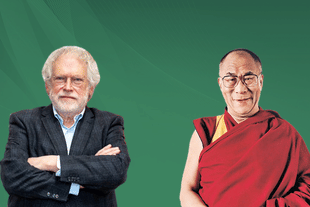Science
The Dalai Lama Connection To This Year's Physics Nobel
Aravindan Neelakandan
Oct 05, 2022, 06:56 PM | Updated 06:56 PM IST
Save & read from anywhere!
Bookmark stories for easy access on any device or the Swarajya app.


Anton Zeilinger, an Austrian quantum physicist is among the three who share the Nobel Prize for Physics this year. The other two are Alain Aspect and John Clauser.
The prize is for 'for experiments with entangled photons, establishing the violation of Bell inequalities and pioneering quantum information science.'
Anton Zeilinger has been a pioneer in the field of Quantum Teleportation. He succeeded in quantum teleporting.
It should be remembered here that quantum teleportation is NOT the ‘beaming’ up one sees in science fiction movies. It is not the physical object that is teleported, but its quantum states.
The paper ‘Experimental Quantum Teleportation’ published in Nature in the December of 1997 by Zeilinger is at the foundation of all these.
In 2016 there was indeed a successful quantum teleportation achieved. Highlighting the role of Zeilinger, Swarajya wrote:
On 16 August 2016, China launched Micius – a satellite which can generate quantum entangled photons. It can send the entangled photons to land stations in Austria and China. Placed at sun-synchronous orbit 500 kilometres above the earth, (1,400 km at horizon), Micius also has ultra-sensitive light detectors, which can detect the quantum states of the photons it gets from the Earth.
With the land station established at 4,000 metres above the altitude at the occupied territory of Tibet (thus reducing the distance of atmospheric interference with the photons), Chinese teams have been creating entangled photon pairs from the base at the rate of 4,000 per second.
Thirty two days and millions of photons later 911 cases turned triumphant. The Chinese team has announced ‘the first quantum teleportation of independent single-photon qubits from a ground observatory to a low Earth orbit satellite — through an up-link channel — with a distance up to 1,400 km’. They have further announced that their achievement ‘establishes the first ground-to-satellite up-link for faithful and ultra-long-distance quantum teleportation, an essential step toward global-scale quantum internet’.
Swarajya also pointed out the inherent paradox in this achievement:
The socio-political paradox of totalitarian Chinese government announcing a major technological breakthrough in the formation of quantum internet is too obvious to ignore. A country, where internet censorship is very high, is moving towards the realisation of quantum internet that provides the highest standards of web-based privacy.
Quantum internet communications based on q-cryptography are theoretically impossible to crack. There are other fundamental ironies as well. Marxist governments have traditionally run inquisition against quantum mechanics. Often their theoreticians denounced the new physics as ‘bourgeois science’ and ‘decadent fall into mysticism’
Sure enough, even in the path to quantum computing and teleportation of the scientists we saw, Bohm was almost a mystic and his conversations with philosopher J Krishnamurthy are legendary. Anton Zeilinger, the man who made the first quantum teleportation over the distance of more than 100 km, had invited the Dalai Lama to his laboratory. He and his colleagues had visited Dharamshala and discussed quantum physics and cosmology with the Dalai Lama.
Anton Zeilinger's interactions with Dalai Lama provides a good framework for the dialogue of science and religion. There is no arrogance on the part of both the scientist and the monk.
The monk does not display any arrogance of spirituality. The scientist also does not take a confrontational attitude. Through Dalai Lama, Buddhism has made strides in its dialogue with science and Anton Zeilinger has been quite a significant instrument in that.
It should be remembered here that during such invitations to Dalai Lama, the Chinese Government, through its network of researchers, would typically launch a campaign protesting his participation in such conferences.
In 2005 one of the petitions read:
The presentation of a religious symbol with a controversial political agenda may cause unnecessary controversies, unwanted press, and significant divisions among SFN members from multiple geographic locations, and with conflicting religious beliefs and political leanings.
But despite such petty-minded obstructions the Zeilinger-Dalai Lama dialogues continued.
The winning of Nobel Prize by Zeilinger, one hopes, will also further catalyse countries like India to move fast in the field and the dialogue between science and Eastern spiritual traditions will result in positive tangible results and not in rationality-challenged fantasies.
Aravindan is a contributing editor at Swarajya.





